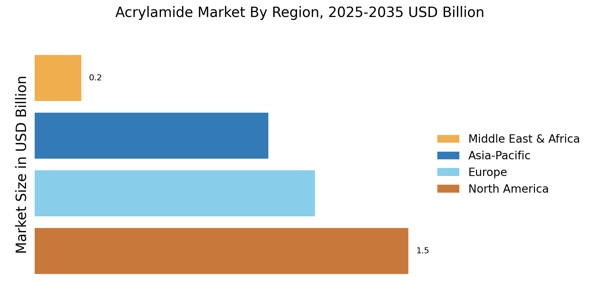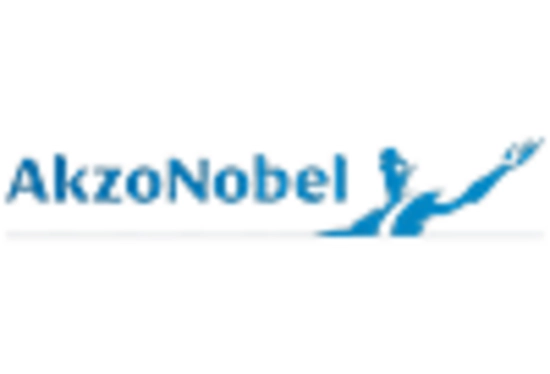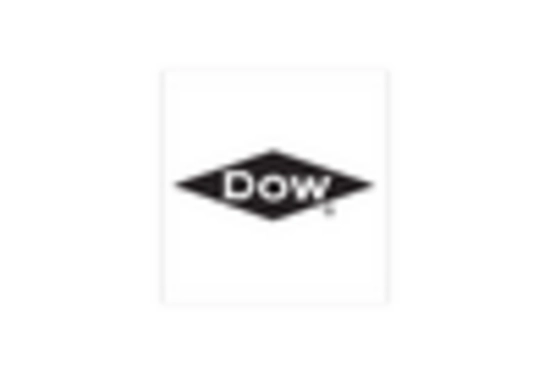Rising Demand in Food Processing
The increasing demand for processed foods is a notable driver in the Acrylamide Market. As consumers seek convenience, the food processing sector has expanded significantly, leading to higher acrylamide levels in various products. According to recent data, the food processing industry is projected to grow at a compound annual growth rate of approximately 5% over the next few years. This growth is likely to result in a corresponding rise in acrylamide production, as it is a byproduct of certain cooking methods, particularly frying and baking. Consequently, the Acrylamide Market is expected to witness heightened scrutiny regarding acrylamide levels in food products, prompting manufacturers to explore mitigation strategies while maintaining product quality.
Increased Research and Development
The Acrylamide Market is experiencing a surge in research and development activities aimed at understanding the implications of acrylamide exposure. With growing awareness of health risks associated with acrylamide, including its potential carcinogenic effects, researchers are focusing on developing methods to reduce its formation during food processing. This trend is supported by various studies indicating that acrylamide levels can be significantly lowered through specific cooking techniques and ingredient modifications. As a result, the market is likely to see innovations in food technology that not only enhance safety but also improve the overall quality of processed foods. The investment in R&D is expected to drive growth in the Acrylamide Market, as companies strive to meet consumer demands for safer food products.
Regulatory Pressures and Guidelines
Regulatory pressures are increasingly shaping the Acrylamide Market, as governments and health organizations implement guidelines to limit acrylamide levels in food products. Various countries have established maximum allowable limits for acrylamide, compelling food manufacturers to adopt stringent quality control measures. For instance, the European Food Safety Authority has issued recommendations for reducing acrylamide in food, which has led to a significant shift in production practices. This regulatory landscape is likely to drive innovation in the Acrylamide Market, as companies seek to comply with these regulations while maintaining product appeal. The ongoing evolution of regulatory frameworks may also create opportunities for businesses that specialize in acrylamide reduction technologies.
Consumer Awareness and Health Concerns
Consumer awareness regarding the health implications of acrylamide is a critical driver in the Acrylamide Market. As information about the potential risks associated with acrylamide exposure becomes more widespread, consumers are increasingly scrutinizing food labels and seeking products with lower acrylamide content. This shift in consumer behavior is prompting food manufacturers to reformulate products and adopt cooking methods that minimize acrylamide formation. Market data suggests that products marketed as low in acrylamide are gaining traction, indicating a potential shift in purchasing patterns. Consequently, the Acrylamide Market is likely to adapt to these changing consumer preferences, leading to innovations in product development and marketing strategies.
Technological Innovations in Food Processing
Technological innovations in food processing are playing a pivotal role in shaping the Acrylamide Market. Advances in cooking technologies, such as microwave and infrared heating, have shown promise in reducing acrylamide formation during food preparation. These technologies not only enhance food safety but also improve energy efficiency in production processes. As manufacturers increasingly adopt these innovative techniques, the Acrylamide Market is expected to witness a transformation in how food products are processed and marketed. Furthermore, the integration of automation and smart technologies in food processing may lead to more consistent quality control, thereby addressing consumer concerns regarding acrylamide levels. This trend suggests a proactive approach to managing acrylamide risks while meeting the demands of a competitive market.


















Leave a Comment